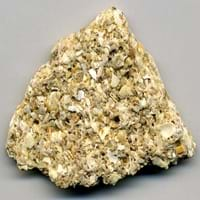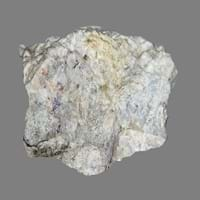Definition
Coquina is a sedimentary rock that is composed either wholly or almost entirely of the transported, abraded, and mechanically-sorted fragments of the shells of molluscs, trilobites, brachiopods, or other invertebrates
Skarns are formed during regional or contact metamorphism and from a variety of metasomatic processes involving fluids of magmatic, metamorphic, and/or marine origin
Origin
European Foreland Basins
USA, Australia
Discoverer
Unknown
Tornebohm
Etymology
From Concha (Latin)+ Coquina(Spanish) +conch(English)= Couquina (mid 19th century)
From an old Swedish mining term originally used to describe a type of silicate gangue or waste rock.
Class
Sedimentary Rocks
Metamorphic Rocks
Sub-Class
Durable Rock, Soft Rock
Durable Rock, Hard Rock
Group
Not Applicable
Not Applicable
Other Categories
Coarse Grained Rock, Opaque Rock
Fine Grained Rock, Opaque Rock
Texture
Clastic
Earthy, Mud-rich, Rough
Color
Beige, Buff, Orange
Black, Brown, Colourless, Green, Grey, White
Durability
Non-Durable
Durable
Appearance
Layered, Banded, Veined and Shiny
Dull
Interior Uses
Decorative Aggregates, Homes, Hotels, Interior Decoration
Decorative Aggregates, Entryways, Interior Decoration
Exterior Uses
Garden Decoration, Office Buildings
As Building Stone, As Facing Stone, Garden Decoration, Paving Stone
Other Architectural Uses
Curbing
Curbing
Construction Industry
Building houses or walls, Construction Aggregate
As a Flux in the Production of Steel and Pig Iron, As a Sintering Agent in Steel Industry to process Iron Ore, As Dimension Stone, Gold and Silver production, Manufacture of Magnesium and Dolomite Refractories
Medical Industry
Not Yet Used
Not Applicable
Antiquity Uses
Artifacts, Monuments, Sculpture, Small Figurines
Artifacts, Monuments, Sculpture
Commercial Uses
Creating Artwork
Creating Artwork, Gemstone, Jewelry, Metallurgical Flux, Source of Magnesia (MgO)
Types
Not Available
Endoskarns
Features
Available in Lots of Colors and Patterns, Is one of the oldest rock
Host Rock for Lead, Zinc and Copper Deposits
Archaeological Significance
Famous Monuments
Data Not Available
Data Not Available
Famous Sculptures
Data Not Available
Data Not Available
Pictographs
Used
Not Used
Petroglyphs
Used
Not Used
Formation
Coquina is a sedimentary rock which is formed when billions of small clam-like seashell, called Coquina, or cockleshell are die and hence are deposited, buried and turns into a rock when pressure is applied.
Due to change in environmental conditions, rocks are heated and pressurized deep inside the Earth's surface. Skarn is formed from the extreme heat caused by magma or by the intense collisions and friction of tectonic plates.
Mineral Content
Apatite, Augite, Bronzite, Calcite, Chert, Chlorite, Clay Minerals, Epidote, Feldspar, Garnet, Micas, Muscovite or Illite
Calcite, Enstatite, Epidote, Garnet, Magnetite, Pyroxene, Titanite
Compound Content
CaO, Carbon Dioxide, Iron(III) Oxide, MgO
Au, CaO, Carbon Dioxide, Cu, Fe, MgO
Types of Metamorphism
Not Applicable
Burial Metamorphism, Cataclastic Metamorphism, Contact Metamorphism, Hydrothermal Metamorphism, Impact Metamorphism, Regional Metamorphism
Types of Weathering
Biological Weathering, Chemical Weathering, Mechanical Weathering
Not Applicable
Types of Erosion
Coastal Erosion, Sea Erosion, Water Erosion, Wind Erosion
Not Applicable
Grain Size
Coarse Grained
Fine Grained
Fracture
Irregular
Irregular
Streak
White
Light to dark brown
Porosity
Highly Porous
Less Porous
Luster
Dull to Vitreous to Submetallic
Waxy and Dull
Cleavage
Not Available
Slaty
Toughness
Not Available
2.4
Specific Gravity
1.10-2.24
2.86
Transparency
Opaque
Opaque
Density
2.8-2.9 g/cm3
2.8-2.9 g/cm3
Specific Heat Capacity
Not Available
Resistance
Heat Resistant, Impact Resistant, Pressure Resistant, Wear Resistant
Heat Resistant
Deposits in Eastern Continents
Asia
Not Yet Found
China, India, Russia, Saudi Arabia, South Korea, Sri Lanka
Africa
Not Yet Found
South Africa, Western Africa
Europe
United Kingdom
United Kingdom
Others
Not Yet Found
Not Yet Found
Deposits in Western Continents
South America
Not Yet Found
Brazil, Colombia, Paraguay
Deposits in Oceania Continent
Australia
Not Yet Found
Central Australia, Western Australia
All about Coquina and Skarn Properties
Know all about Coquina and Skarn properties here. All properties of rocks are important as they define the type of rock and its application. Coquina belongs to Sedimentary Rocks while Skarn belongs to Metamorphic Rocks.Texture of Coquina is Clastic whereas that of Skarn is Earthy, Mud-rich, Rough. Coquina appears Layered, Banded, Veined and Shiny and Skarn appears Dull. The luster of Coquina is dull to vitreous to submetallic while that of Skarn is waxy and dull. Coquina is available in beige, buff, orange colors whereas Skarn is available in black, brown, colourless, green, grey, white colors. The commercial uses of Coquina are creating artwork and that of Skarn are creating artwork, gemstone, jewelry, metallurgical flux, source of magnesia (mgo).










